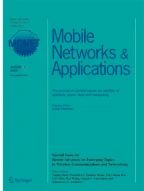Abstract
As the world of technology offers a rapidly increasing number of outlets for creativity and communications, a worldwide education is undergoing a significant renovation. Today, students can have the access to virtual classroom from anywhere, at any time. While E-learning, E-education and remote education are highly encouraged thanks to their obvious advantages, there is a necessity to explore the network service, QoS, organization and structure of these modern teaching-learning approaches. Widely adopted by numerous universities and institutions, the remote distributed virtual laboratory is an important technology for delivering highly efficient and effective E-learning, E-education and remote education in many disciplines. For this reason, in this paper, a number of key problems of this critical technology are discussed, with the goal of providing references and solutions for successful and smooth implementation.
Similar content being viewed by others
Explore related subjects
Discover the latest articles, news and stories from top researchers in related subjects.References
Guo L, Guo Y, Yihua Z, Yuhai S (2003) The virtual lab system. The Journal of China Universities of Posts and Telecommunications 10(2):81–84
Nedic Z, Machotka J, Nafalski A (2003) Remote laboratories versus virtual and real laboratories. IEEE Frontiers in Education 1:T3E-1–T3E-6
Jara CA, Candelas FA, Puente ST, Torres F (2011) Hands-on experiences of undergraduate students in automatics and robotics using a virtual and remote laboratory. Comput Educ 57(4):2451–2461
Caminero A, Ros S, Hernandez R, Roblesgomez A, Tobarra L, Tolbanos P (2016) Virtual remote laboratories management system (tutores): using cloud computing to acquire university practical skills. IEEE Trans Learn Technol 9(2):133–145
Bora UJ, Ahmed M (2013) E-learning using cloud computing. Int J Sci Modern Eng 1(2):9–13
Selviandro N, Hasibuan ZA (2013) Cloud-Based e-learning: a proposed model and benefits by using e-learning based on cloud computing for educational institution. International Conference on Information and Communication Technology 7804:192–201
Corter JE, Nickerson JV, Esche SK, Chassapis C (2004) Remote versus hands-on labs: a comparative study. Frontiers in Education. IEEE Frontiers in Education 2:F1G-17–F1G-21
Shaheen M, Loparo KA, Buchner M (1998) Remote laboratory experimentation. American Control Conference. IEEE American Control Conference 2:1326–1329
Schmid C (1998) The virtual control lab VCLab for education on the Web. American Control Conference. IEEE American Control Conference 2:1314–1318
Casini M, Garulli A, Prattichizzo D, Vicino A (2003) Remote system identification in the "automatic control telelab" environment. IEEE Conference on Decision & Control 5:4956–4961
Bhandari A, Shor MH (1998) Access to an instructional control laboratory experiment through the World Wide Web. American Control Conference. IEEE Xplore 2:1319–1325
Casini M, Prattichizzo D, Vicino A (2001) The Automatic Control Telelab: a remote control engineering laboratory. IEEE Conference on Decision & Control 4:3242–3247
Sureshbhosale Y, Jenila LLM (2014) V-lab: a mobile virtual lab for network security studies. Int J Comput Appl 93(20):35–38
Liu H, Dan O (2010) Remote network labs: an on-demand network cloud for configuration testing. ACM 40(1):83–91
Ros S, Robles-Gomez A, Hernandez R, Caminero AC, Pastor R (2012) Using virtualization and automatic evaluation: adapting network services management courses to the ehea. IEEE Trans Educ 55(2):196–202
Rajurikar NS, Kulkarni SV, Patane RD (2017) Implementation of Centralized Lab of an Embedded Web server using CoAP Protocol on cloud computing. IEEE International Conference on Recent Trends in Electronics, Information and Communication Technology 2267–2272
Shukhman AE, Polezhaev PN, Legashev LV, Ushakov YA, Bolodurina IP (2017) Creation of regional center for shared access to educational software based on cloud technology. IEEE Global Engineering Education Conference 916–919
Gasparetti F, De MC, Limongelli C, Sciarrone F, Temperini M (2017) Prerequisites between learning objects: Automatic extraction based on a machine learning approach. Telematics Inform 35(3):595–610
Zhou JT, Zhao H, Peng X, Fang M, Qin Z, Goh RSM (2018) Transfer Hashing: From Shallow to Deep. IEEE Transactions on Neural Networks and Learning Systems 99:1–11
Matijevic MS, Jovic ND, Nedeljkovic MS, Cantrak DS (2017) Remote labs and problem oriented engineering education. IEEE Global Engineering Education Conference 1391–1396
Acknowledgments
This work is supported by the National Natural Science Foundation of China (61771154) and the Fundamental Research Funds for the Central Universities (HEUCFG201830).
Meantime, all the authors declare that there is no conflict of interests regarding the publication of this article.
We gratefully thank of very useful discussions of reviewers.
Author information
Authors and Affiliations
Corresponding author
Rights and permissions
About this article
Cite this article
Lin, Y., Wang, S., Wu, Q. et al. Key Technologies and Solutions of Remote Distributed Virtual Laboratory for E-Learning and E-Education. Mobile Netw Appl 24, 18–24 (2019). https://doi.org/10.1007/s11036-018-1130-z
Published:
Issue Date:
DOI: https://doi.org/10.1007/s11036-018-1130-z
